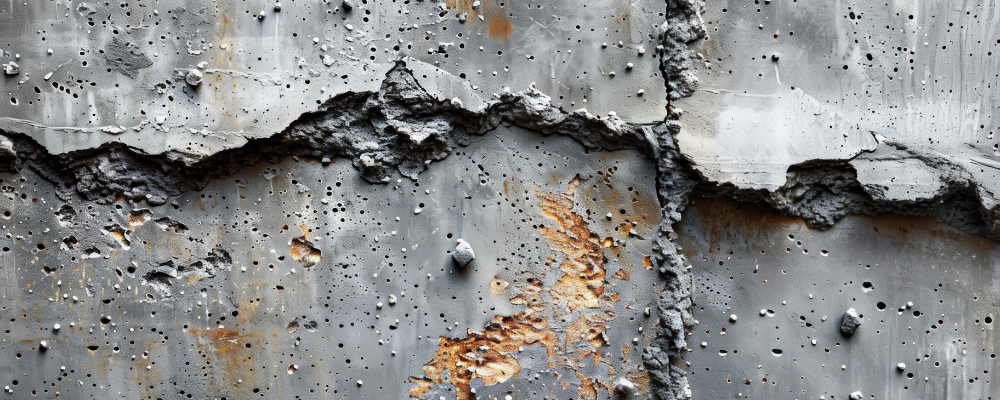Concrete is one of the most frequently used materials for modern construction. Its strength, durability and ease in workability, combined with ready availability of labour make it a popular choice for home construction. However, one of the common drawbacks faced with its use is concrete corrosion. It is thus essential to understand what exactly concrete corrosion means, its causes and prevention of corrosion. This blog provides a comprehensive guide for the same.
What is Concrete Corrosion?
Concrete is made up of cement, sand, water and aggregates. Corrosion of concrete refers to the degradation or deterioration of its component materials. Physical and structural changes caused by concrete corrosion reduce concrete durability and building lifespan. It can cause substantial damage to a building and endanger the safety of its residents.
What Causes Concrete Corrosion?
Several physical, chemical and biological factors affect concrete and lead to its corrosion. Careful consideration of and planning for these can help in prevention.
- Improper Design
Proper design of shuttering is required to prevent leakage of concrete during the pouring process. Water-cement ratio is also an essential factor, neglection or improper use of which can result in loss in concrete strength and development of cracks, leading to water permeability and eventually concrete corrosion.
- Improper Execution
Improper mixing and shuttering or formwork, insufficient curing and compaction can all lead to the development of cracks, which speed up the process of corrosion. Use of low quality component materials such as low corrosion resistance steel for reinforcement or low grade cement can also enhance concrete corrosion.
- Excess Humidity
Exposure to excess relative humidity can increase the pH levels of wet concrete and make it acidic, leading to corrosion of reinforcement in concrete. It also fosters the growth of mould, mildew and bacteria that can decrease concrete strength and result in concrete corrosion.
- Exposure to Corrosive Substances
Groundwater or treated water often consists of salts and acids of sulphur, chlorides and nitrates along with microbial organisms. Curing or even later exposure through cleaning with such water can drastically enhance concrete corrosion. These acidic substances are particularly harmful to steel reinforcement, leading to rapid rusting and corrosion.
What are the Effects and Indicators of Concrete Corrosion?
Concrete corrosion has physical and biological effects that can compromise the integrity of the building’s structure. These are generally visible to the naked eye through physical indicators.
- Formation of Cracks
This is the primary indication and effect of concrete corrosion. The sign can begin with the development of hairline cracks, which eventually widen to form structural cracks. They are generally caused by improper curing and lead to increased permeability, resulting in corrosion, mainly of reinforcement members.
- Spalling
The development of patches or flakes that are separated from the substrate layers of concrete is termed as spalling. It is a common effect in cold climates, but can also develop due to exposure to fire. Spalling weakens the structure and causes surface breakage.
- Exposed Steel Bars
Caused mainly by incorrect concreting techniques or freeze thawing, exposed steel bars are a clear indication of the deteriorating condition of concrete. Exposure of steel leads to quicker rusting, resulting in quicker loss in quality of concrete.
- Structural Deformity and Collapse
Major steel and concrete corrosion can lead to structural damages such as deformity and failure in reinforcement. This can further lead to instability of the structure and eventual collapse of the building. Safety precautions must be taken in order to ensure that concrete corrosion does not reach this extreme stage.
What are the Methods to Prevent Corrosion?
Several foolproof physical, chemical and biological techniques exist to prevent concrete corrosion and ensure its durability. Some of these are discussed below.
- Ensure Quality of Concrete
Extensive supervision by qualified experts is necessary before, during and after the process of concreting. Skilful labour that can assure proper formwork, shuttering, pouring, compaction and adequate curing are essential to ensure quality and durability of concrete that is resistant to cracks which lead to corrosion.
- Reinforcement with Non Corrosive Materials
Concrete is typically reinforced with structural steel bars of different diameters, which are vulnerable to rust. Replacing these with non corrosive materials like stainless steel, epoxy-coated steel or Fibre Reinforced Polymer (FRP) can reduce the probability of concrete corrosion. However, this technique is generally cost intensive.
- Admixtures
Organic and inorganic inhibitors can be added to the concrete mix. These prevent chemicals like sulphates and chlorides from penetrating the concrete surface, which slows down rusting of steel reinforcement by the formation of a protective layer. Use of such admixtures is a simple and cost effective method to prevent corrosion.
- Coating Materials or Sealants
Treating visible surfaces of concrete with lacquer-based paint, varnish, plaster or oil can reduce the area exposed to environmental factors that would otherwise negatively affect it. Use of epoxy coating to obtain a polished look or covering the concrete surface with flooring, cladding and other surface finishing materials can also prevent concrete corrosion.
- Use of Intelligent Sensors
Intelligent sensors are a relatively new technology that can ensure the quality of concrete. They persistently monitor construction sites and even finished buildings to give timely warnings on any deterioration or reduction in quality, thus reducing dependency on manual labour and assuring reliability.
Repair and Cure for Corroded Concrete
Minor corrosion of concrete such as cracks can typically be repaired by patching or filling with new concrete or plaster, as required. However, major damages cannot generally be repaired and replacement of these elements is necessitated to ensure building safety and integrity. Therefore, it is advisable to prevent occurence of concrete corrosion by ensuring good quality during construction.
Brick & Bolt conducts 470+ quality checks by expert teams at every stage of construction, to assure the best concrete quality and durability. Contact Brick & Bolt to build your dream home today!

